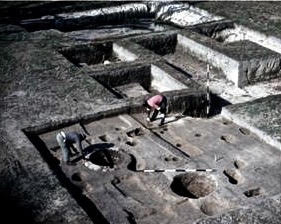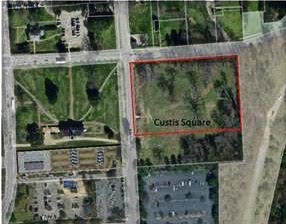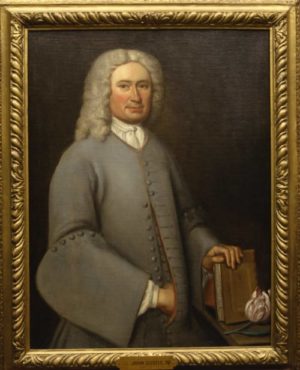
WILLIAMSBURG, Va. (March 19, 2019) – This winter the Colonial Williamsburg Foundation launches a multi-year archaeological investigation at the site of John Custis IV’s city home and gardens, known as Custis Square, promising new findings about the life of the eccentric politician, planter and first father-in-law to Martha Washington, the enslaved people living on the site, and early 18th-century horticulture.
The Custis Square project is expected to create 10 multi-year archaeology positions in the foundation. A generous lead gift from the Jacqueline Badger Mars Landmark Investments 8, LLC Charitable Lead Trust is helping to make the Custis archaeology project possible.
“More than 90 years after its establishment, Colonial Williamsburg continues to pursue a fuller understanding of 18th-century America, its people and their culture in order to tell our shared American story more fully,” said Colonial Williamsburg President and CEO Mitchell B. Reiss. “We are enormously grateful for the generous gift that has launched the Custis Square project, and we look forward to sharing both our work and our findings with visitors of all ages.”
Custis lived from 1678 until 1749, leading a prosperous family that first settled on Virginia’s Eastern Shore in the mid-17th century. After his turbulent marriage to Frances Parke Custis ended with her death of smallpox in 1715, he moved to the colony’s capital of Williamsburg. There, he served as a member of the royal Governor’s Council, immersed himself in horticulture and constructed an elaborate garden on his four-acre property. Custis Square was maintained by some of his enslaved laborers, who at the time of his death numbered nearly 200, most of whom worked on his four plantations outside the city.
“The shared history we interpret at Colonial Williamsburg is not static. It grows daily, enhanced by the research of our team and our peers,” said Colonial Williamsburg Director of Archaeology Jack Gary. “Our new investigation of Custis Square is thrilling both in scale and subject matter, given all we stand to learn about the people who lived and worked on this ground early in an era of political and scientific enlightenment.”
As a young man, John Custis IV studied trade in England and likely observed formal gardens that fostered his hobby. Back in Virginia, records show that he ordered a range of plants through agents in England and corresponded with prominent naturalists including Peter Collinson, Mark Catesby and Jon Bartram, who placed his garden among the finest in the colony.
Frances Parke and John Custis IV’s son, Daniel Parke Custis, married Martha Dandridge in 1750 and died suddenly in 1757. Martha Dandridge Custis may have lived at the family’s Williamsburg home after his death and until her remarriage in 1759 to George Washington.
Like other prominent Virginians, John Custis IV lamented slavery but did not free his own enslaved. With one of them, Alice, as a 61-year-old widower he fathered a son named John whom he affectionately called “my boy Jack.” John Custis IV successfully petitioned the colony’s governor and council for Jack’s freedom, deeded him land in York County and enslaved persons including his own mother and her other children, and willed him construction of a furnished home. Jack, however, died in 1751 just two years after his father.
Often combative, John Custis IV fell out with Lt. Gov. Alexander Spotswood after Spotswood cut down trees on his property to enhance his view from the new Governor’s Palace. John Custis IV’s volatile relationship with his wife – and his personality – are memorialized on his Eastern Shore grave, which reads, “Yet lived but Seven years which was the Space of time he kept a Batchelors House at Arlington on the Eastern Shoar of Virginia.”
In the decades immediately following John Custis IV’s death, Custis Square housed residential and trade tenants. The structure that stands on the site, though known as the “Custis Kitchen,” was built in the early 19th century during the property’s ownership by Dr. James McClurg. The property was purchased in 1851 and partially built upon by the current Eastern State Hospital, later used as a park and purchased by Colonial Williamsburg in 1966.

Partial site excavation in 1964. Colonial Williamsburg Foundation
Partial excavations in the 1960s uncovered the foundations of the property’s residence, which is believed to have been a six-chimney building in the Jacobean style of Bacon’s Castle in Surry County, as well as an older kitchen, a smokehouse, a brick drain, two wells and a road extending south from the structures. The new investigation is broader in scope and will benefit from advancements in methodology and technology, including remote sensing and materials analysis.
The Custis Square project’s areas of investigation include:
- The flora and aesthetic of John Custis IV’s gardens
- Evidence of residential structures that housed the enslaved
- Identification of John Custis IV’s enslaved and their descendants
- The appearance of John Custis IV’s residence
- Evidence of pre-historic occupation
- Activity on the site through the 20th century

Custis Square on Francis Street between S. Nassau Street and the Colonial Parkway with investigation area highlighted in red. Colonial Williamsburg Foundation
The project’s phases include:
- Site mapping and surveying; excavation of the McClurg Kitchen (2019)
- Open excavation of garden areas, materials analysis and research of John Custis IV’s enslaved to identify potential descendants (2020-21)
- Open excavation of outbuildings focused on the lives and work of the enslaved (2022-23)
- Cataloging and reporting (2024-25)
Custis Square currently serves as a grazing pasture for Colonial Williamsburg Coach and Livestock Department animals, opposite S. Nassau Street from the Art Museums of Colonial Williamsburg, which remain open during a $41.7-million expansion scheduled for completion in spring 2020 with a new, dedicated entrance on S. Nassau Street. Colonial Williamsburg also plans construction of a new, public archaeological collections building to house the more than 60 million archaeological artifacts in its collection – a project possible thanks to a generous gift by Mars’ late brother, Forrest Mars Jr.
___________________________

John Custis IV, attributed to Charles Bridges, oil on canvas, ca. 1740. Courtesy of Washington and Lee University, University Collections of Art and History, Lexington, Virginia
___________________________
Article Source: Colonial Williamsburg Foundation news release
Colonial Williamsburg will share updates and findings on its Making History blog at colonialwilliamsburg.com/archaeology. Information is also available by following Colonial Williamsburg on Facebook and @colonialwmsburg on Twitter and Instagram.
Admission tickets and additional information about Colonial Williamsburg sites and programming are available atcolonialwilliamsburg.com or by calling 855-296-6627 toll-free. Information is also available via the free Colonial Williamsburg Explorer app, which can be downloaded from the Apple App Store and Google Play.





